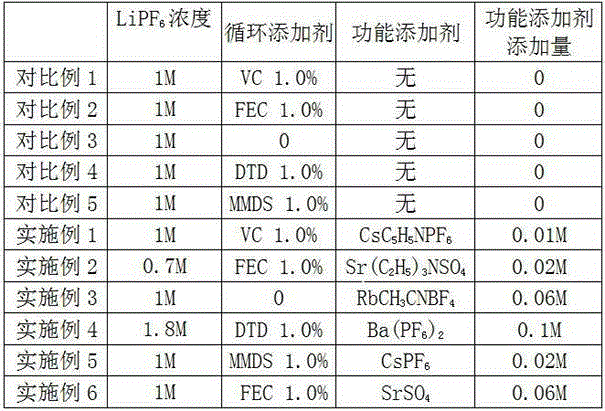High-voltage electrolyte and high-voltage lithium ion battery
A lithium-ion battery, high-voltage technology, used in secondary batteries, circuits, electrical components, etc., can solve the problems of cycle performance damage, shortening battery life, and increasing battery internal resistance.
- Summary
- Abstract
- Description
- Claims
- Application Information
AI Technical Summary
Problems solved by technology
Method used
Image
Examples
Embodiment 1
[0020] 1. Electrolyte preparation: The electrolyte is prepared in a BRAUN glove box filled with nitrogen gas with a purity of 99.999%, the moisture in the glove box is controlled at ≤5ppm, and the temperature is at room temperature. Mix the solvent system with a mass ratio of EC:EMC:DEC=3:3:4 evenly, seal it, put it in the refrigerator until it cools down to 8°C, transfer it to the glove box, and then add LiPF in two batches 6 Mix well to form a non-aqueous electrolyte solution for lithium-ion batteries with a lithium salt molar concentration of 1mol / L. Add 1% of the conventional high-voltage electrolyte additive VC to the above non-aqueous electrolyte solution, and continue to add CsC after mixing evenly. 5 h 5 NPF 6 Make it contain 0.01M CsC 5 h 5 NPF 6 The non-aqueous electrolyte solution is uniformly mixed to obtain a lithium-ion non-aqueous electrolyte solution.
[0021] 2. Preparation of positive electrode for lithium-ion battery: Dissolve polyvinylidene fluoride (P...
PUM
| Property | Measurement | Unit |
|---|---|---|
| density | aaaaa | aaaaa |
Abstract
Description
Claims
Application Information
 Login to View More
Login to View More - R&D
- Intellectual Property
- Life Sciences
- Materials
- Tech Scout
- Unparalleled Data Quality
- Higher Quality Content
- 60% Fewer Hallucinations
Browse by: Latest US Patents, China's latest patents, Technical Efficacy Thesaurus, Application Domain, Technology Topic, Popular Technical Reports.
© 2025 PatSnap. All rights reserved.Legal|Privacy policy|Modern Slavery Act Transparency Statement|Sitemap|About US| Contact US: help@patsnap.com



